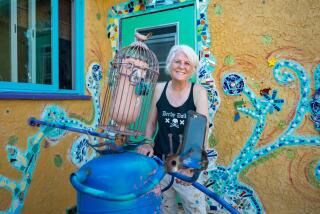Walter De Maria, celebrated sculptor, dies at 77
Walter De Maria, the artist and sometime musician whose monumental sculptures and installations combined the simplicity of minimalism with a love of scale, died Thursday at age 77. The cause of death was a stroke, according to his New York studio.
Throughout his career, De Maria cultivated a somewhat reclusive personality as far as the media was concerned. He seldom gave interviews and disliked being photographed. He also avoided participating in museum shows when he could, preferring to create his installations outdoors or at unconventional urban locations.
As a result, his work was not widely exhibited in the U.S. and he never became a household name. But critics championed his work, finding his large-scale installations to be conceptual and intellectually complex, while at the same time accessible to the general public.
PHOTOS: Arts and culture in pictures by The Times
His most famous creation was “The Lightning Field,” a land-art piece created in 1977 in New Mexico consisting of 400 polished stainless steel poles arranged in a rectangular array that is 1 kilometer long and 1 mile wide.
In October, the artist presented his installation “The 2000 Sculpture” at the Los Angeles County Museum of Art, where it occupied most of the Resnick Pavilion. The piece consisted of 2,000 white rods arranged to form a geometric tesselation, creating different reflections of light.
“I think he’s one of the greatest artists of our time,” said LACMA director Michael Govan, who had worked with De Maria for a number of years. “I think there’s a quality to his work that is singular. It was sublime and direct.”
“The 2000 Sculpture” was used to test the light quality of Resnick Pavilion when it was preparing to open and was later displayed for the public.
Govan said De Maria shunned the media because “he wanted the work to stand for itself.”
The artist had a long working relationship with the Dia Art Foundation, which Govan headed in New York.
ART: Can you guess the high price?
De Maria was born in Albany, Calif., and eventually settled in New York. His work was more widely shown abroad than in the U.S., and he had major exhibitions in Japan and Europe.
Some of his installations are still on view to the public. In addition to “The Lightning Field” in New Mexico, he created “The New York Earth Room,” at 141 Wooster St. in New York; and “The Broken Kilometer” at 393 West Broadway, also in New York.
In addition to his art career, De Maria was a sometime musician who played drums for the New York-based rock band The Primitives in the 1960s.
His survivors include his mother, Christine De Maria; his brother, Terry; three nieces; four nephews; and one grand niece.
Complete obituary: Walter De Maria dies at 77; artist known for large installations
[For the record, 10:37 a.m., July 26: The photo credit on an earlier version of this post misspelled the last name of the foundation that supplied the photo. It is the Walter A. Bechtler Foundation, not Bechter.]
ALSO:
Walter De Maria’s huge art installation has the floor at LACMA
Review: Walter De Maria’s ‘2000 Sculpture’ a fine fit at LACMA
More to Read
The biggest entertainment stories
Get our big stories about Hollywood, film, television, music, arts, culture and more right in your inbox as soon as they publish.
You may occasionally receive promotional content from the Los Angeles Times.











